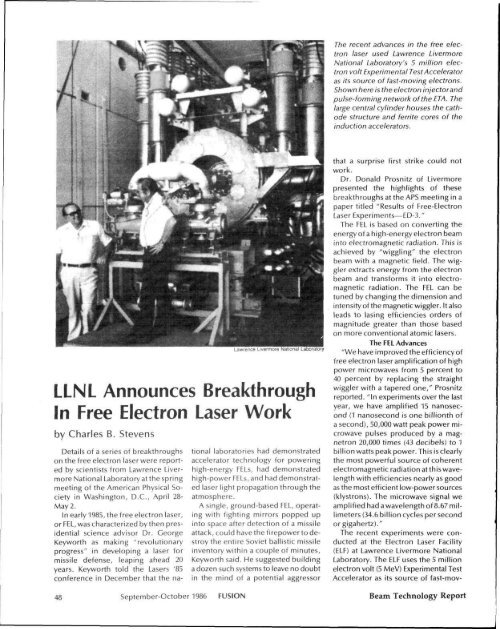You also want an ePaper? Increase the reach of your titles
YUMPU automatically turns print PDFs into web optimized ePapers that Google loves.
Lawrence Livermore National Laboratory<br />
LLNL Announces Breakthrough<br />
In Free Electron Laser Work<br />
by Charles B. Stevens<br />
Details <strong>of</strong> a series <strong>of</strong> breakthroughs<br />
on the free electron laser were reported<br />
by scientists from Lawrence Livermore<br />
National Laboratory at the spring<br />
meeting <strong>of</strong> the American Physical Society<br />
in Washington, D.C., April 28-<br />
May2.<br />
In early 1985, the free electron laser,<br />
or FEL, was characterized by then presidential<br />
science advisor Dr. George<br />
Keyworth as making "revolutionary<br />
progress" in developing a laser for<br />
missile defense, leaping ahead 20<br />
years. Keyworth told the Lasers '85<br />
conference in December that the na<br />
tional laboratories had demonstrated<br />
accelerator technology for powering<br />
high-energy FELs, had demonstrated<br />
high-power FELs, and had demonstrated<br />
laser light propagation through the<br />
atmosphere.<br />
A single, ground-based FEL, operating<br />
with fighting mirrors popped up<br />
into space after detection <strong>of</strong> a missile<br />
attack, could have the firepower to destroy<br />
the entire Soviet ballistic missile<br />
inventory within a couple <strong>of</strong> minutes,<br />
Keyworth said. He suggested building<br />
a dozen such systems to leave no doubt<br />
in the mind <strong>of</strong> a potential aggressor<br />
<strong>The</strong> recent advances in the free electron<br />
laser used Lawrence Livermore<br />
National Laboratory's 5 million electron<br />
volt Experimental Test Accelerator<br />
as its source <strong>of</strong> fast-moving electrons.<br />
Shown here is the electron injector and<br />
pulse-forming network <strong>of</strong> the ETA. <strong>The</strong><br />
large central cylinder houses the cathode<br />
structure and ferrite cores <strong>of</strong> the<br />
induction accelerators.<br />
that a surprise first strike could not<br />
work.<br />
Dr. Donald Prosnitz <strong>of</strong> Livermore<br />
presented the highlights <strong>of</strong> these<br />
breakthroughs at the APS meeting in a<br />
paper titled "Results <strong>of</strong> Free-Electron<br />
Laser Experiments—ED-3."<br />
<strong>The</strong> FEL is based on converting the<br />
energy <strong>of</strong> a high-energy electron beam<br />
into electromagnetic radiation. This is<br />
achieved by "wiggling" the electron<br />
beam with a magnetic field. <strong>The</strong> wiggler<br />
extracts energy from the electron<br />
beam and transforms it into electromagnetic<br />
radiation. <strong>The</strong> FEL can be<br />
tuned by changing the dimension and<br />
intensity <strong>of</strong> the magnetic wiggler. It also<br />
leads to lasing efficiencies orders <strong>of</strong><br />
magnitude greater than those based<br />
on more conventional atomic lasers.<br />
<strong>The</strong> FEL Advances<br />
"We have improved the efficiency <strong>of</strong><br />
free electron laser amplification <strong>of</strong> high<br />
power microwaves from 5 percent to<br />
40 percent by replacing the straight<br />
wiggler with a tapered one," Prosnitz<br />
reported. "In experiments over the last<br />
year, we have amplified 15 nanosecond<br />
(1 nanosecond is one billionth <strong>of</strong><br />
a second), 50,000 watt peak power microwave<br />
pulses produced by a magnetron<br />
20,000 times (43 decibels) to 1<br />
billion watts peak power. This is clearly<br />
the most powerful source <strong>of</strong> coherent<br />
electromagnetic radiation atthiswavelength<br />
with efficiencies nearly as good<br />
as the most efficient low-power sou rces<br />
(klystrons). <strong>The</strong> microwave signal we<br />
amplified had a wavelength <strong>of</strong> 8.67 millimeters<br />
(34.6 billion cycles per second<br />
or gigahertz)."<br />
<strong>The</strong> recent experiments were conducted<br />
at the Electron Laser Facility<br />
(ELF) at Lawrence Livermore National<br />
Laboratory. <strong>The</strong> ELF uses the 5 million<br />
electron volt (5 MeV) Experimental Test<br />
Accelerator as its source <strong>of</strong> fast-mov-<br />
48 September-October 1986 FUSION Beam Technology Report

















